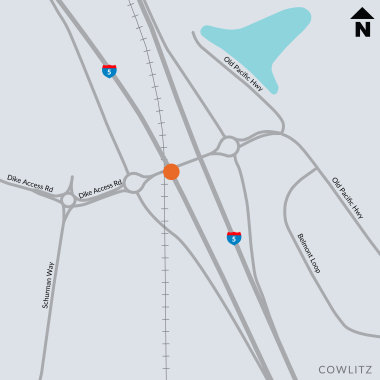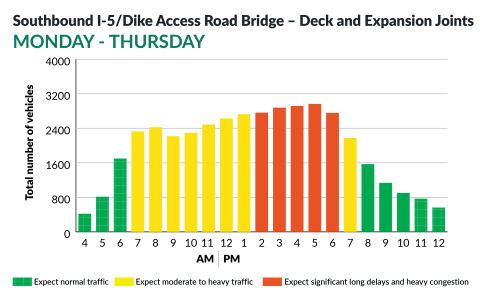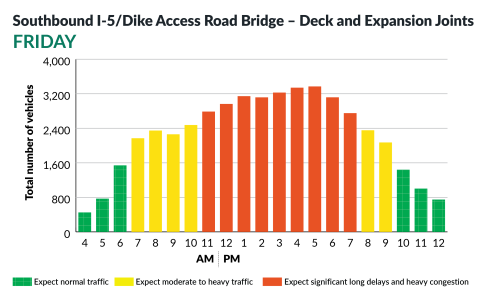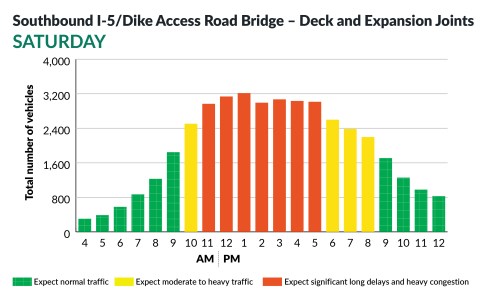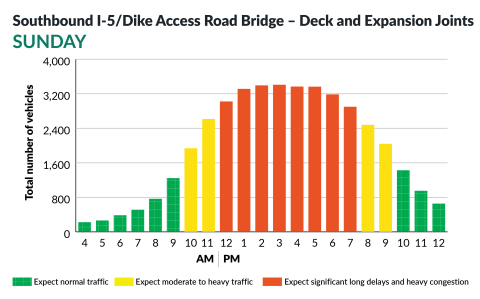Project overview
In spring 2024, contractor crews will begin work to improve the southbound lanes of the I-5 Dike Access Road Bridge that spans over Dike Access Road and the railroad bridge, just north of Woodland, in Cowlitz County, WA.
What to expect
Expect significant delays during peak travel times!
Beginning at 7 p.m., Thursday, May 2, and continuing until further notice: an around-the-clock single lane closure and speed limit reductions will be in place, leading up to and along the southbound I-5 Dike Access Road Bridge deck.
Construction work will be performed by working on half of each bridge deck at a time. To create a safe work zone, temporary traffic barrier will be placed down the center of the bridge, and traffic will be reduced and shifted from three lanes down to two narrow lanes (10 feet and 10.5 feet wide) and narrow shoulders.
Additionally, the speed limit will be reduced from 70 mph down to 60 mph through the work zone, and reduced again down to 45 mph along the bridge.
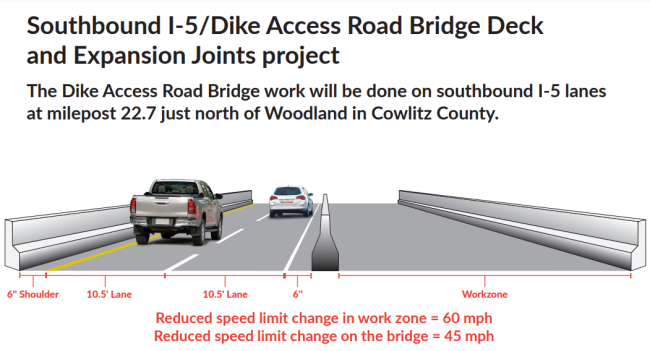
To improve safety, minimize delays and reduce congestion, contractor crews will utilize a temporary Smart Work Zone System and zipper merging throughout the work zone.
What is a Smart Work Zone?
Using sensor technology, the Smart Work Zone System analyzes roadway conditions to give travelers real-time traffic information on reader board signs which will be placed at one-mile intervals leading up to the work zone. Providing travelers with real-time traffic information helps increase safety by allowing people to make more efficient driving choices as they approach a work zone. In addition to providing real-time traffic information, the reader board signs will provide travelers with an advanced warning that a traffic taper/traffic revision is ahead. This advanced warning system is designed to increase safety by notifying travelers in advance that they'll begin merging into the reduced number of travel lanes.
What is zipper merging?
As travelers approach the work zone, they'll be directed to begin merging from three full travel lanes down to two narrow travel lanes, across the bridge. To accomplish this, travelers will use zipper merging driving the full length of the travel lane and merging just before the lane ends.
Generally, the length of a work zone (closed lane) has minimal effect on traffic delays - the majority of the delays occur at the point where traffic begins merging into the reduced number of lanes.
While it may seem counterintuitive, the early merger who is trying be polite and wait in the queue often makes congestion worse than the driver who merges closer to the end of the travel lane.
Studies have shown that when traveler’s zipper merge, congestion can be reduced by up to 40 percent, while reducing crashes, backups and delays.
In spring 2024, contractor crews will work to remove and replace the existing asphalt overlay along the southbound span of the I-5-Dike Access Road Bridge. Crews will also remove and replace the expansion joints, creating a smoother, safer driving surface for travelers for many years to come.

